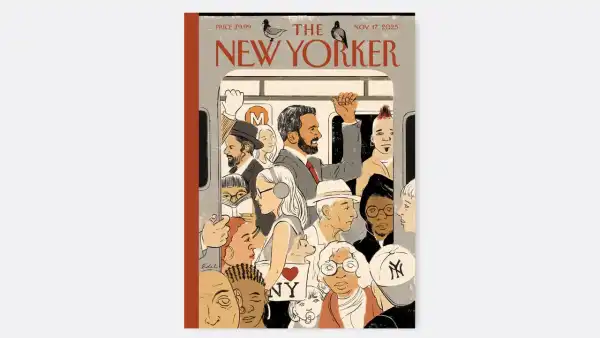
Save this storySave this storySave this storySave this storyYou’re reading Infinite Scroll, Kyle Chayka’s weekly piece about how technology molds culture.
There exist numerous paths to attaining significance on social platforms, yet they diverge notably in value. An account might be associated with a well-known company or a celebrity, whose digital fan base is essentially guaranteed, requiring minimal effort. Alternatively, an individual’s internet fame can be organic and well-earned, achieved through active engagement to attract followers on a specific social network, akin to Emily Mariko’s success on TikTok in 2021, where she cultivated a viewership that has presently reached twelve million with wordless cooking demonstrations of salmon rice bowls and related content. An account could also secure online recognition as a reliable authority in a particular subject, exemplified by the economic historian Adam Tooze, who boasts over two hundred thousand followers on X—substantial, but not excessively so. However, in numerous instances, a sizable audience today may indicate a dearth of genuine enthusiasm—the majority of followers may consist of bots, detractors, and inactive accounts, as demonstrated by minimal interaction on the user’s actual posts. Furthermore, now that social networking has influenced culture for well over a decade, a large portion of prominent accounts belong to figures from a past epoch of fame; they represent the establishment rather than the cutting edge. The music producer Jack Antonoff, whose creative zenith occurred in the twenty-tens, maintains over half a million followers on X, while the celebrated emerging artist Nourished by Time possesses just over three thousand. Which account offers superior value? Elevated numbers no longer inherently signify relevance or influence, given that social media has become more mature, susceptible to manipulation, and automated by artificial intelligence.
As the reliability of a large follower count diminishes, the inverse—a notably small following—has garnered a specific appeal. In a recent installment of her popular newsletter, Feed Me, the writer Emily Sundberg lauded the incoming head editor of the publication Air Mail, Julia Vitale, for her restrained social-media engagement: “I admire her under-500 follower count on her private Instagram,” Sundberg noted. In an edition of the fashion newsletter Blackbird Spyplane titled “Now That’s How You Post,” the writer Jonah Weiner similarly applauded the stylist Lotta Volkova for her casual posting style on Instagram and her indifference towards her images (depicting an ordinary river scene, or a line of storage units) receiving only a few hundred likes or a limited number of comments. Previously, this might have been viewed as embarrassing for an account with nearly a half million followers. Volkova’s mindset, Weiner summarizes, is “Who cares?” A certain status accompanies the act of overlooking conventional indicators of online success, and an admiration is sparked by individuals capable of forging a career without the burden of performing on social networks. Sundberg confided, “In an era where individuals are perpetually posting details about their lives online to seek attention, one becomes almost resentful that someone can achieve success without resorting to such measures.” One’s own overexposure then feels shameful by comparison. Weiner, who operates a personal Instagram account with roughly three hundred followers, stated, “If your ego and your livelihood seem dependent on these platforms, you might also project an enviable financial stability, as well as an enviable emotional stability, onto someone who abstains from using them entirely.”
When did accumulating numerous followers lose its inherent allure? It is a post-pandemic phenomenon. During the peak of COVID, online audiences expanded significantly as people across the globe, confined to their homes, increased their screen time. TikTok, recently gaining traction in the United States, had a boosted algorithmic system that enabled users to acquire millions of followers practically instantaneously. Instagram has adopted a similar strategy with Reels, motivating legions of new, prosperous content creators. However, as time passed, audience attention waned in intensity. As users have become more reliant on algorithmic suggestions, they have grown accustomed to passively following the feed rather than actively seeking out specific accounts. This implies that optimizing content to exploit the algorithm has become simpler. Grace Clarke, the community director at a large e-commerce technology company, mentioned, “Gaining a large audience is actually no longer ‘expensive,’ meaning difficult or rare. It is simple to manipulate.” Simultaneously, users have gravitated towards more tailored digital publishing platforms, spanning from YouTube to Patreon, where niche and dedicated audiences can unite around creators of their choosing. According to an analysis performed for the Financial Times, the total time spent on conventional social networking sites peaked in 2022 and has been declining ever since. The largest platforms, in the meantime, are primarily occupied by passive consumers who lack the motivation to unfollow accounts that no longer interest them. When did you last review your Facebook connections or evaluate your following list on X?
The allure of online obscurity reminds me of a principle advocated by a friend who manages social accounts for a global company: professional social-media managers ought to maintain disorganized, unoptimized personal accounts. “It’s a type of flex to have poor photography and unrefined content,” she remarked. You possess the capability to produce polished content—knowing how to do so is part of your job, after all—but that does not necessitate replicating this in your personal time. In fact, refraining from excessive hustle may ironically present you as more professional and reliable, since you are not overly focused on perfecting your own profile. The professionalization of social media itself constitutes a significant reason why amassing vast numbers of followers can now appear in poor taste. While social networking in the early twenty-tens was often a pastime or a personal endeavor, today the relationship between follower and followee has become intensely commercialized. Personal social-media accounts now function as promotional spaces for podcasts, subscription newsletters, Depop listings, cryptocurrency schemes, and shopping referral links. Saarim Zaman, the founder of a startup that employs technology to facilitate in-person gatherings, stated, “It just feels like everything suddenly became transactional.” He cited, as an example, a trend on X where users respond to breaking-news events by posting screenshots of their bets on Polymarket, the platform that enables wagering on world events. These posters are essentially “talking their books,” as it is known in finance, much like an investor promoting a startup in which they hold a stake, endeavoring to persuade others to invest in their perspective and thus increase their potential profits. Building an audience has become progressively intertwined with the objective of generating income.
For all of these reasons, we have been trained to view excessive online visibility with suspicion. We might prefer if our authority figures behaved more like the “offline boyfriend,” a persona celebrated, in a 2022 New York article, for his “remarkably limited social-media presence.” The low-follower accounts I appreciate most seem guided by the preferences of their owners rather than the desires of the internet audience. The designer Mike Sunday shares posts concerning vintage tech aesthetics on X. The illustrator Colleen Tighe posts leftist labor art and unpretentious Barcelona snapshots on Instagram. The poet Erin Taylor posts Instagram stories featuring her readings, literary memes, and glimpses into the creative process. The internet tastemaker Raihan Anwar thoughtfully shares his reflections on music, coffee, technology, and fragrances on Instagram. None of these profiles possess significantly more than five thousand followers. It is typically regarded as uncool to follow a larger number of people than follow you, yet Anwar exhibits this reversed “ratio” on his private Instagram account, two to one. He disclosed that he regards a modest online audience as an indication that someone tends to “socialize more in the real world.” Perhaps adopting a deliberately understated approach on Instagram suggests a distinct form of dedication: the commitment to resist the allure of the screen and cultivate influence in physical settings. Maintaining a low follower count represents a distinct form of discipline. ♦
Sourse: newyorker.com






